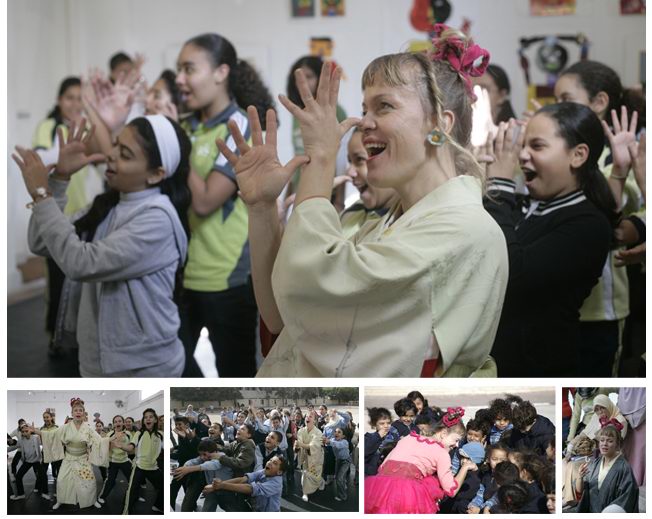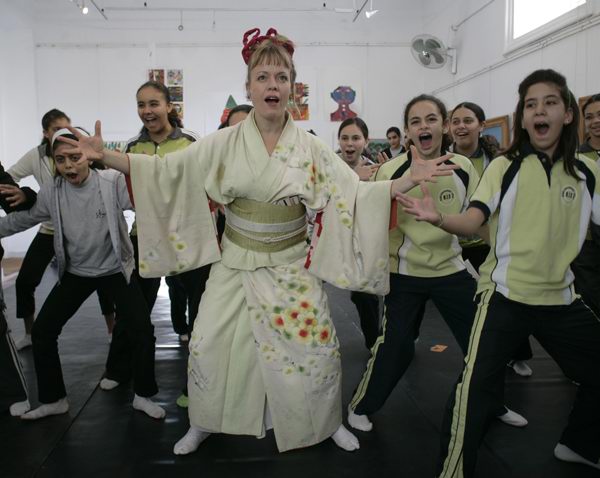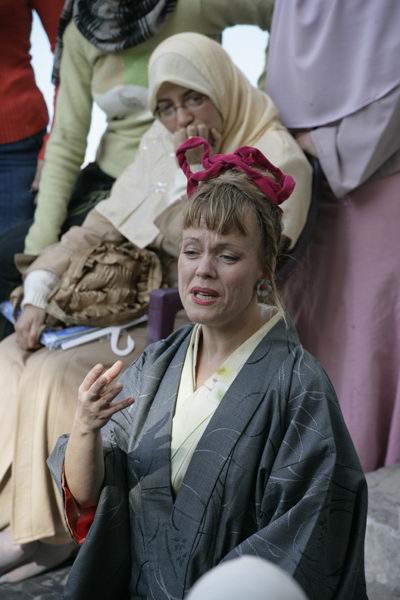
|
HiddenMysteries.com HiddenMysteries.net HiddenMysteries.org |
* * * * * * * * * * * * * * * * * * * * * * * * * * * * * * * * * * * * * * *
A word from our sponsor

The Swedish sensei
Sunday, December 28 2008 @ 09:38 PM CST
Increase font Decrease font
This option not available all articles
Japanese art is brought to Egyptians by a Swedish, Giovanna Montalbetti and photographer Sherif Sonbol are intrigued
Dressed in a flowered kimono, she proceeds in small silent steps. She is wearing the Tabi -- Japanese special socks -- that make her feet look funny. The children catch their breath as she moves closer; they have never seen anything like her. Their faces show amusement, warmth and surprise. On seeing her no one would imagine the strength -- both physical and spiritual -- this woman hides. Her petite figure and her friendly features make her a charming vision, delicate as a porcelain doll. She is here to bring a taste of Japanese culture to Egyptian children, but her dark blond hair pulled up in a playful bun gives away she is not from Japanese ancestry. Ami Skanberg fell in love with Japanese culture on a trip to Kyoto. Since then she has perfected herself in different Japanese cultural disciplines, continuing her dance studies with sensei ("master teacher" or "mentor") Nishikawa Senrei. "I fell in love with the choreographed codes, the dance, the kimono, my sensei, the fans...," she recalls. "I wanted to learn everything." She may not have been born Japanese, but she makes a wonderful ambassador for the Land of the Rising Sun.
Skanberg was educated at Balettakademien in Gothenburg, Sweden. She is a multi-faceted artist (dancer, choreographer, actress, teacher and writer), and a woman who knows how to balance her pursue for freedom with the love for her family. She is happily married and has two children, which may account in part for the talent she has in addressing young audiences. She has visited Egypt on several occasions, this time invited by the Bibliotheca Alexandrina in collaboration with l'Atelier d'Alexandrie, to perform and interact with children form three schools (a public, an English and a German school).
Her workshops allow children to get in touch with some of the ancient Japanese traditions. Her class begins with 20 minutes of samurai walk, the daily training for Japanese dancers, which is performed in total silence. "You warm up both body and mind, and leave the outer world outside," she explains. "It works with children, for they get focussed and concentrated, something they really need today." After that comes the Cherry-blossom dance, a dance celebrating the beauty of life even when it is short, as represented in the metaphor of the cherry blossom petals falling in the wind; and the Tadanobu, a samurai dance. Although it takes months of intense training to master these routines, Skanberg has devised simplified versions for her workshops, enabling children (and grown-ups too) to enjoy the most of the experience: at one of the schools, the teachers spontaneously joined the workshop carried away by the magic of the moment.
This Swedish sensei manages to convey such heartwarming feelings that the children even dare taste Japanese green tea despite it having no sugar. The unexpected flavour will be not too popular amongst most of them, but the experience is met with laughter. If a good teacher is supposed to broaden the student's minds, Skanberg is a great teacher indeed.
Apart from her Japanese culture workshops, Skanberg returned to the schools in order to perform for the younger classes a ballerina solo, in which she plays the jewellery-box ballerina stuck in a spot until she finally breaks free, her dance metamorphosing from contained and more standard ballet, to something wild and almost acrobatic. Freedom is a recurrent theme of Skanberg's work: "Individuals are always trapped in society," she told Al-Ahram Weekly. "There are rules, there are schedules. But if we can manage to find spaces and places in between that make our directions go not one way, but many different ways, then we won't feel trapped." She believes one becomes free through knowledge and art, for they lead to self awareness and to one's own particular happiness.
Maybe because they have been less modelled by society's restraints than adults, children seem to receive her message naturally. She says children from around the world -- she has held these workshops in Australia and Sweden -- react the same way to the experience. Even though some find it interesting and beautiful while others ugly or just very strange, they all laugh and appreciate the historic value of the 700-year-old samurai music. This is why Skanberg was bewildered by an incident that occurred at one of the schools: "a teacher at a public school became very scared", she explains. "She was screaming about what I was doing and she was not comfortable when I told the children there are two different religions in Japan -- Buddhism and Shintoism. The teacher thought I came to head a Japanese invasion now that America had fallen. She kept saying nobody cared for their warriors and dances, that it's their technology that is worth something. She kept confusing China and Japan, saying all came from China these days (yet I am Swedish!). I felt a bit sad and shocked to hear a teacher speak like this in front of the children. The international schools could relate to other things and their teachers could help their children to reflect on things, because they weren't afraid of me."
As for the children, there seemed to be unanimous agreement on what part of the workshop was most fun: although it was girls more than boys who enjoyed the Cherry-blossom dance, other kids were thrilled by the tiny stepped walking discipline; but all of them relished the samurai dance, in which they enact sword moves (imaginary swords), and learn to scream samurai-style to tease the enemy.
Not so many like the taste of green tea, but they appreciated the ceremony attached to the drinking, in which they are reminded to enjoy the small things in life. Skanberg, well aware of the problem with diabetes, hopes they will eventually add drinking green tea to their lifestyle, without sugar, in order to preserve their health.
When asked what she would like the children to take away with them from this experience, Skanberg said she wished it will help them discover the beauty of movements in nature, allowing them to seek for the silent movements that they possess themselves, practising them at home, in the desert, or in a botanical garden.
One of the lessons from these ancient ways is something that may seem contrary to the world we are living in: you don't have to be rich to enjoy life. According to Skanberg, for Japanese there is poetry even in the way green tea leaves float on water, like clouds in the sky. They see the world in their tea cup. It is probably this approach to life and its basics that allows them to achieve great things. Gratefulness, discipline, grace and concentration are ingredients always infused in Japanese tradition.
Skanberg feels Egyptian culture has some similar aspects to that of Japanese: "I thought kimono being a long sleeved long dress, would blend in with a country where most women cover in long galabiyas," she renders. "I also thought the strictness of Japanese tradition could in a way be easier for Egyptians than if I taught, for example, a jazz dance class with free improvisation."
She also thought of the parallelism between geishas and Egyptian almahs: "Geishas are absolutely not prostitutes," Skanberg reminds us. "Geisha means artist, but a highly paid one. Geishas could also be men. In Egypt there was the tradition of almah, highly educated women who could perform in court. Their art was poetry, dancing, singing, music playing, writing... Just like geisha."
Skanberg also explains Japanese dance is becoming very rare even in Japan, as people find it too slow and strict to fit in contemporary times. She feels this is something also happening in Egypt, where the frantic rhythm of modern life is making some traditions -- and the different sense of time perception they imply -- become obsolete.
Through her different visits to Egypt, Ami Skanberg has been conquered by the warmth of the audience she finds here. She has performed to Arabic music in Japan, and believes Japanese people should learn to move with the ease and spontaneity Egyptians do. From her visits she gathered inspiration for one of her most celebrated choreographies, in which she mixed her own experiences with that of Mervat, an oasis girl.
She is now working on a project in Sweden with seventh grade children, in which she dances for and with them in order to help them become open-minded, tolerant and to make them take part in their culture-history.
To her, her experience in the Alexandria workshops was very enriching: "It is proof that anyone can learn something about a different culture via dance and music, and not only study an impersonal list of names and dates. Dance and music allow history to enter both your body and mind."
The Bibliotheca Alexandrina is pleased with her workshops and wishes her to return. She is already thinking of bringing her husband and two children next time, in order to savour a city they all love. And while the details of Skanberg's next visit to Alexandria are being discussed, she has already scheduled a rehearsal for a play in Cairo in 2010, with Swedish director Charlie Éström.
Skanberg will again visit Egypt, and on each visit she will keep bringing cultures closer together through the universal language of art.
ahram.org.eg





Comments (0)
* * * * * * * * * * * * * * * * * * * * * * * * * * * * * * * * * * * * * * *
A word from our sponsor

HiddenMysteries
Main Headlines Page
Main Article Page
The Swedish sensei
http://www.hiddenmysteries.net/newz/article.php/2008122821382012
Check out these other Fine TGS sites
HiddenMysteries.com
HiddenMysteries.net
HiddenMysteries.org
RadioFreeTexas.org
TexasNationalPress.com
TGSPublishing.com
ReptilianAgenda.com
NationofTexas.com
Texas Nationalist Movement